 |
- Events
- Recordings
- Scores
- Overview of Publications
- Publication Index
- Solo Harp
- Sonata - Mr Naderman comes to Wales
- The Birth of the Moon over the Marsh of Rhuddlan
- Petite Suite
- A Garland for the Harp
- A Welsh Landscape
- Mozart Sonata in C K545
- Variations on a theme of Spohr
- Handel Aria con Variazioni
- Meyer Sonata in G Minor
- Domenico Scarlatti
- Priest Composers
- Mozart Adagio for Solo Harp
- Music for a Play
- Impromptu (1972)
- Jesu, Joy of Man's Desiring
- First Easy-Medium Book
- First Medium-Difficult Book
- Passacaglia
- Instrumental Duo
- Voice & Harp
- Chamber Music
- Written for David Watkins
- Harpist
- Gallery
- Downloads
- Links
- Contact
- Home
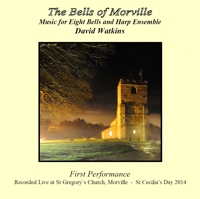 The
Bells of Morville
The
Bells of Morville
David Watkins (harp), Michael
Bochmann (violin), Jane Leslie MacKenzie (soprano)
Live recording of St. Cecilia's Day Concert - November 2014 at St. Gregory's Church, Morville with the first performance of David Watkins' "The Bells of Morville"
RRP £12.00
Available on line from Creighton's Collection and most other good harps stores
Return
to previous page
Click here for the sheet music for The Bells of Morville
| 1 | The Bells of Morville - David Watkins | 12:15 |
| 2 | Pieta Signore - Stradella | 6:11 |
| 3 | Allegro - John Parry | 2:33 |
| 4 | Ave Maria - Bach/Gounod | 4:53 |
| 5 | Siciliano & Allegro - Bach | 3:58 |
| 6 | Abendempfindung - Mozart | 5:12 |
| 7 | Voi che sapete - Mozart | 2:50 |
| 8 | Meditation from Thais - Massenet | 5:44 |
| 9 | Two Welsh Folk Songs - arr David Watkins | 3:07 |
| 10 | Country Gardens - arr Michael Bochmann | 2:10 |
| 11 | Silent Night - arr David Watkins | 3:01 |
| 12 | Allegro moderato - C F Abel | 3:10 |
| 13 | Still Still Still - arr Adrian Cleaton | 2:57 |
| 14 | Bells ringing down | 4:53 |
TOTAL TIME |
63:50 |
|
Sleeve Notes
THE BELLS OF MORVILLE
On a visit to Morville, David Watkins was struck by the beauty of Morville and the surrounding area and after reading ‘The Morville Hours’ by Katherine Swift, his fascination with Morville grew. Katherine furthermore inspired David, not only with her insights into gardening and its history, but with her perceptive understanding of the Shropshire landscape and the origins of Morville with its Benedictine monastery.
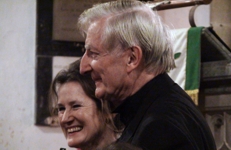 |
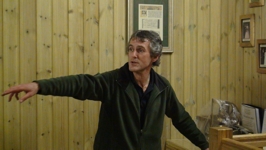 |
| Katherine & David | Ian Rowe - Tower captain |
The Tower Captain, Ian Rowe, introduced David to the Morville bells during a weekly bell ringing practice. David became so further inspired by the extraordinary acoustics of the mediaeval Church and its magnificent set of bells that he began a work for harp ensemble juxtaposed with the bells.
Composition
1. The Bells of Morville David Watkins
‘The Bells of Morville’ celebrates Christmas with Alleluias, the Annunciation and the birth of Christ in mediaeval and traditional carols.
As the sound of the bells fades, the harps quietly emerge, becoming stronger and stronger until at the highest point a peal of harp notes rings out loudly, eventually dying away to nothing. In the silence, alleluias are heard reminding us of the monks who sang in this Church. To mediaeval ears the Alleluia was the overpowering expression of the ecstasy of the spirit, a joy that could not be restricted to words and brought with it a feeling of the cleansing of the soul. This Alleluia “Vere tu es Rex” (‘Indeed thou art King’) was sung for the Feast of the Holy Family. These Alleluias then mutate, combining with belllike scales and a chorale to welcome the birth of Jesus.
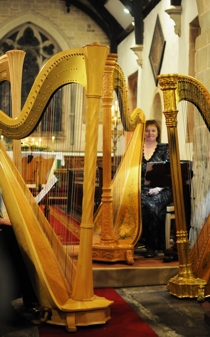 |
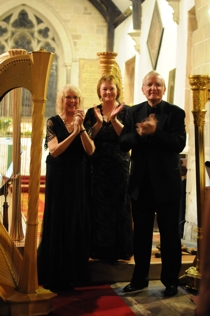 |
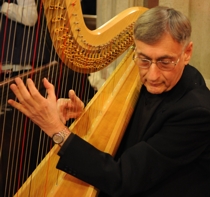 |
| Harp Ensemble: Helen Barley, Eleri Lloyd, David Watkins & Frank Sternefeld | ||
Three versions of the ‘Coventry Carol’ follow. This astonishingly beautiful lullaby dates from the fifteenth century and seems to have been first performed at the Pageant of Shearmen and Tailors in Coventry. It is a lullaby for the Christ child but we are reminded to be vigilant at Herod’s calculated treachery.
The intimate and heartfelt lullaby is soon transformed into the joyful and dance-like “Angelus ad Virginem” (‘The Angel unto Mary’). It was very popular in fourteenth century England and Chaucer mentioned it in his“Miller’s Tale”. There it is sung by Nicholas, the Clerk of Oxenford, who accompanies himself on the psaltery.
On which
he made a nightes melodye
so swetely, that all the chambre rong;
And “Angelus ad Virginem” he song.
The musical excitement continues to build up and is transformed into the fifteenth century German carol “Puer Nobis Nascitur”
Unto us is
born a Son,
King of choirs supernal:
See on earth his life begun,
Of Lords the Lord eternal.
(Tr. by G.R. Woodward)
The work finishes with brilliant and loud glissandi up and down the harps and then the eight bells of Morville come crashing in with joyful abandon.
This Work was commissioned by Adrian Cleaton and is dedicated to harpist Eleri Lloyd.
The music in this CD is enfolded in the hypnotic pealing of bells which for centuries called people to church for their devotions.
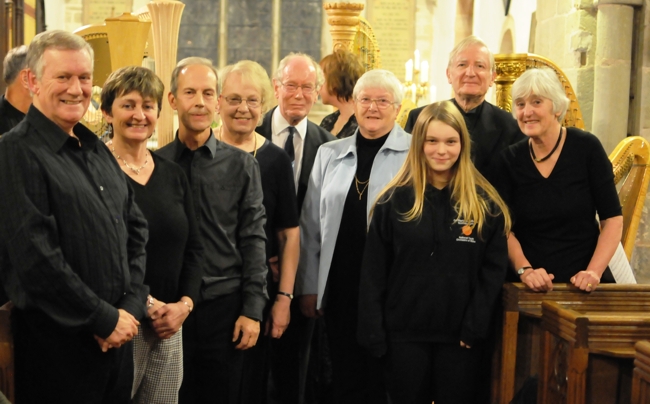 |
| The Bell Ringers: Peter Sell, Penny Salisbury, Martin Bluck, Val Roberts, Neil Bennett, Ann Bennett, Emily Davies, Heather Kippin |
2. Pieta Signore A supplication to God to forgive us our sins and, by his grace, to heal us all but not to cast us into everlasting flames.
3. Allegro John Parry (1710-1782). Blind from birth and one of the greatest harpists of his age, he inspired Thomas Gray to complete his ballad “The Bard” and set the poet ‘dancing’.
4. Ave Maria “Hail Mary, blessed forever, pray for us at the time of our death”
5. Siciliano & Allegro Bach’s own paraphrase of “Erbarme Dich” the heartfelt aria from the St Matthew Passion. Peter weeps when the cock crows, having denied Jesus three times. The Allegro is one of Bach’s astringent and rhythmic fast movements.
6. Abendempfindung (Thoughts at evening) “when you come to my grave your tears will become the most precious pearls in my crown”
7. Voi Che Sapete (from the Marriage of Figaro) The young and ardent Cherubino is confused when he falls in love with every woman he sees.
8. The Meditation from the Opera Thais. The beautiful courtesan Thais wants to redeem herself and this music plays at the moment she longs for change.
9. Two Welsh Folksongs David of the White Rock. David, the dying harpist, asks his family to bring his harp to him so he can play it for the last time. “Last night an angel appeared to me asking me to play my harp as I ascend to heaven”. The Miller’s Song. The Miller is looking for a wife and so, to entice her, he sings a catalogue of his possessions.
10. Country Gardens Michael Bochmann composed this ingenious and humorous arrangement which reminds us of the folk dances which once were so much a part of village life.
11 & 12. Still, Still, Still and Silent Night Magical moments of peace and wonder as lullabies are sung for the Christ Child.
13. Allegro Moderato Carl Friedrich Abel (1723-1787). Abel was a close friend of Johann Christian Bach and wrote this joyful allegro for the Welsh Harpist, Edward Jones.
14. Ringing Down the Bells As the audience left the Church, the bells were rung down to a safe position. As the sound dies away, one can hear the waterfall outside in the nearby Mor Brook.
Professor David Watkins FGSM, Hon ARAM November 2014
Michael
Bochmann, Jane Leslie MacKenzie & David
Watkins |
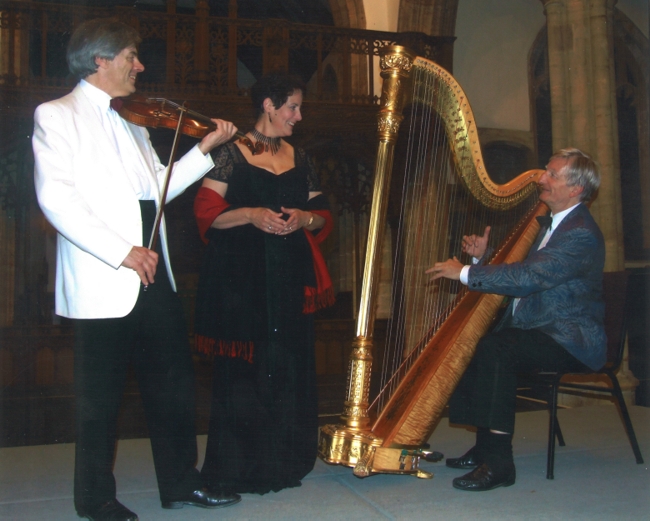 |
Biographies
Jane Leslie MacKenzie
One of the great sopranos of her generation, having sung title roles with The Royal Opera House, Covent Garden, English National Opera, Opera North, Scottish Opera, Welsh National Opera and sought by Opera Houses around the world.
Michael Bochmann
He partnered Sir Yehudi Menuhin in many concerts in Bach’s Concerto for two violins. Well known as a soloist in recitals and concertos, his recording of Vaughan Williams’ ‘Lark Ascending’ has been broadcast many times. He is leader of the English Symphony Orchestra, and Violin Professor at Trinity Laban College.
For further information visit www.michaelbochmann.com
David Watkins
He was Principal Harpist at The Royal Opera House, Covent Garden, Welsh National Opera, Royal Philharmonic and London Philharmonic Orchestras. Soloist and prolific composer, he performed his own harp concerto with the London Philharmonic at the Royal Festival Hall. For many years he was Harp Professor at the Guildhall School of Music and Drama.
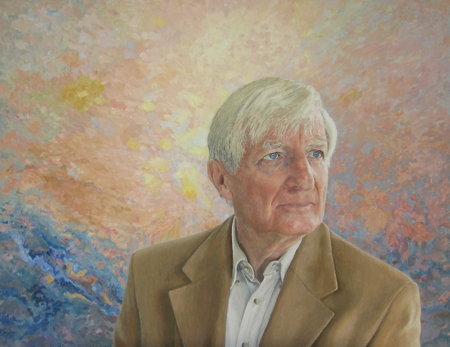 |
This live recording of the whole Concert and the first performance of ‘The Bells of Morville’ is perhaps the apotheosis of his career as Musician, Composer and Harpist.
Credits
Painting of David Watkins by Mary Holt
Recordings by Adrian Cleaton and Paul Arden-Taylor
Photographs
by Nicholas Holt and Rodney Towers
Design and Layout by Rodney
Towers
© Copyright ‘The Bells of Morville’ David
Watkins Two Welsh Folksongs from ‘The Welsh Landscape’ Publisher
Adlais Distributor Creighton’s Collection for CDs and
Sheet Music www.cccd.co.uk